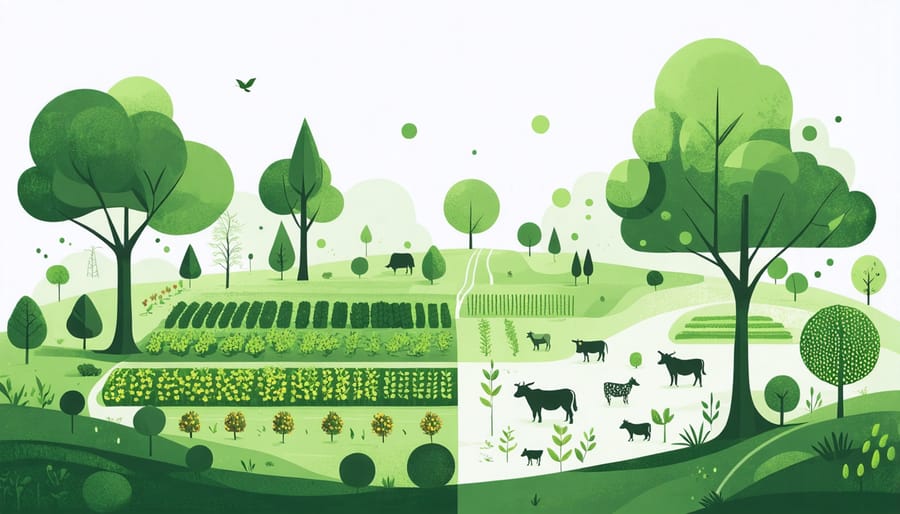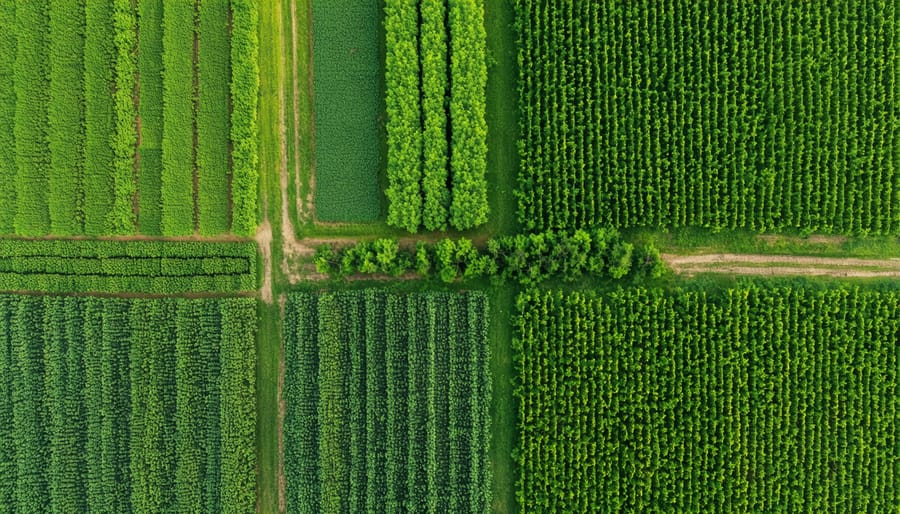Rotate diverse cover crops to fix nitrogen, improve soil health, and suppress weeds. Implement integrated pest management, using beneficial insects, crop rotation, and targeted pesticides to control pests sustainably. Adopt precision agriculture technologies like variable rate application and GPS guidance to optimize inputs and minimize waste. Incorporate agroforestry practices such as shelterbelts and silvopasture to diversify income, sequester carbon, and enhance biodiversity. Utilize conservation tillage methods, including no-till and strip-till, to reduce soil erosion, conserve moisture, and improve soil structure. Manage grazing strategically through rotational and adaptive multi-paddock grazing to promote pasture health and livestock productivity. Collaborate with local conservation groups, universities, and government agencies to access resources, share knowledge, and collectively advance sustainable agriculture in Alberta.
1. Crop Rotation and Diversity

Example Crop Rotation Plan
Here’s an example of a multi-year crop rotation plan well-suited for Alberta’s climate and soil conditions:
Year 1: Plant nitrogen-fixing pulse crops like field peas or lentils. These legumes add nutrients to the soil, reducing the need for synthetic fertilizers. Follow with a cover crop mix of oats, radishes, and clover to prevent erosion and further enrich the soil.
Year 2: Sow a cereal grain such as wheat, barley, or oats. These crops utilize the nitrogen fixed by the previous year’s pulses, leading to higher yields. After harvest, plant a cover crop of winter rye to protect the soil and suppress weeds.
Year 3: Introduce a broadleaf crop like canola or flax, which interrupts pest and disease cycles affecting cereals. Follow with a diverse cover crop blend to enhance soil health and biodiversity.
Year 4: Return to a nitrogen-fixing pulse crop, restarting the rotation cycle. Adapt the specific crops and cover crop mixes based on your farm’s unique needs and market opportunities.
2. Cover Cropping
Cover cropping is a powerful technique that Alberta farmers can employ to enhance soil health and sustainability during off-seasons. By strategically planting cover crops like clover, rye, or oats between main crop rotations, farmers can infuse their soil with essential nutrients, boost organic matter, and improve overall fertility. These hardworking plants act as a natural fertilizer factory, fixing nitrogen from the atmosphere and making it readily available for the next season’s crops.
But the benefits don’t stop there. Cover crops also serve as a protective shield against erosion, with their dense root systems holding soil in place during heavy rains or strong winds. This is especially crucial in Alberta’s diverse landscapes, from the rolling hills of the Peace Region to the vast prairies of the south. By minimizing soil loss, cover cropping helps maintain the land’s productivity for generations to come.
Moreover, cover crops are master water managers. Their roots create a network of channels that allow water to penetrate deeper into the soil profile, improving its water retention capacity. This is a game-changer for Alberta farmers facing increasingly variable precipitation patterns. With better moisture management, crops can better withstand dry spells and thrive with less irrigation.
Incorporating cover cropping into your farm’s management plan is a win-win strategy. It not only enhances soil health but also reduces the need for synthetic fertilizers and herbicides, saving you money in the long run. Plus, by keeping the soil covered year-round, you create a haven for beneficial insects and pollinators, promoting biodiversity on your land.
Ready to give it a try? Start by selecting cover crop species that suit your farm’s unique conditions and goals. Many Alberta farmers have found success with a mix of legumes and grasses, such as peas and barley or vetch and wheat. Experiment with different combinations and seeding rates to find what works best for you. With patience and persistence, cover cropping can transform your farm into a more resilient, sustainable, and profitable operation.
For even more soil-building power, consider combining cover cropping with no-till farming techniques. Together, these practices can supercharge your soil’s health and take your farm’s sustainability to the next level.
3. Minimizing Tillage
Minimizing tillage is a cornerstone of sustainable agriculture that offers numerous benefits for soil health and crop productivity. By reducing or eliminating tillage, farmers can preserve the natural structure of the soil, maintaining its ability to retain moisture, nutrients, and beneficial microbes. This practice helps to prevent soil erosion, which is a significant concern in many parts of Alberta due to wind and water forces.
No-till farming involves planting crops directly into the residue of the previous harvest, without disturbing the soil. This approach allows organic matter to build up over time, improving soil fertility and reducing the need for synthetic fertilizers. The increased organic matter also enhances the soil’s capacity to hold water, making crops more resilient to drought conditions.
Reduced tillage methods, such as strip-tillage or ridge-tillage, offer a compromise between no-till and conventional tillage. These techniques involve minimal soil disturbance, often only in the planting row, while leaving the majority of the field undisturbed. By adopting these practices, farmers can enjoy many of the benefits of no-till while still managing crop residue and preparing the seedbed.
In addition to preserving soil structure and organic matter, minimizing tillage promotes the growth of beneficial soil microbes. These microorganisms play crucial roles in nutrient cycling, disease suppression, and soil aggregation. By providing a stable habitat for these microbes, reduced tillage helps to maintain a healthy and diverse soil ecosystem.
Transitioning to reduced or no-till farming may require some adjustments in management practices and equipment. However, the long-term benefits for soil health, crop productivity, and environmental sustainability make it a worthwhile investment for Alberta farmers.

4. Integrating Livestock
Managed Grazing Techniques
Managed grazing techniques involve strategically moving livestock to different pastures or paddocks, allowing grass to recover and regrow. This improves soil health, increases carbon sequestration, and enhances forage quality. Alberta ranchers have found success with rotational grazing, where cattle are moved every few days to fresh pasture, and the grazed area is given time to rest. Another effective method is mob grazing, which involves high-density, short-duration grazing followed by long recovery periods. This stimulates root growth and nutrient cycling. Silvopasture, the integration of trees and grazing, offers shade for livestock and increases carbon storage. Proper stocking rates, based on pasture capacity, prevent overgrazing. By implementing these techniques, Alberta farmers can boost productivity, reduce feed costs, and contribute to a more sustainable agricultural system.
5. Efficient Irrigation and Water Management
Efficient irrigation and water management are crucial for sustainable agriculture in Alberta. Implementing water-saving methods like drip irrigation, which delivers water directly to plant roots, can significantly reduce waste and costs. Monitoring soil moisture levels using sensors or manual checks helps farmers apply water only when needed, preventing overwatering and runoff. Mulching with organic materials like straw or compost retains soil moisture, reduces evaporation, and suppresses weeds. Planting cover crops and using conservation tillage practices improve soil structure and water retention. Collecting rainwater in cisterns or ponds provides an eco-friendly irrigation source during dry spells. Proper irrigation scheduling based on crop requirements and weather conditions optimizes water use efficiency. By adopting these sustainable water management practices, Alberta farmers can conserve resources, lower expenses, and maintain healthy, productive crops. Combining efficient irrigation with other sustainable methods like crop rotation and biological controls creates a holistic approach to water conservation in agriculture.
6. Integrated Pest Management (IPM)
Integrated Pest Management (IPM) offers a sustainable approach to controlling pests and diseases in crops. By combining biological controls, targeted interventions, and preventative measures, IPM minimizes the need for chemical pesticides. Biological controls involve using natural predators or parasites to keep pest populations in check. For example, ladybugs can be released to control aphids, while certain wasps parasitize crop-damaging caterpillars. Targeted interventions, such as pheromone traps or spot-spraying, address specific pest issues without impacting beneficial insects. Preventative strategies, like crop rotation, companion planting, and maintaining healthy soil, create an environment less conducive to pest outbreaks.
IPM also emphasizes monitoring pest populations and understanding their life cycles to intervene at the most effective times. This data-driven approach reduces unnecessary treatments and helps build resilience in the agricultural ecosystem. By integrating IPM with other sustainable practices like cover cropping, agroforestry, and diverse cropping systems, farmers can create a robust and balanced environment that naturally suppresses pests. Adopting IPM not only reduces costs associated with pesticides but also promotes biodiversity, protects beneficial insects, and enhances overall ecosystem health on the farm.
7. Agroforestry and Permaculture Design
Agroforestry and permaculture design offer innovative solutions for Alberta farmers seeking to create resilient, productive agricultural ecosystems. By strategically integrating trees, shrubs, and perennial plants alongside crops or livestock, farmers can harness the power of natural systems to enhance soil health, biodiversity, and water management. Practices like alley cropping, where crops are grown between rows of trees, provide shade, wind protection, and nutrient cycling benefits. Silvopasture systems, which combine grazing animals with trees, can improve animal welfare and increase land productivity. Food forests, designed to mimic natural ecosystems, feature multiple layers of edible plants that work together to create a self-sustaining, low-maintenance food production system. These approaches not only yield diverse harvests but also sequester carbon, reduce erosion, and create wildlife habitats. By embracing agroforestry and permaculture principles, Alberta farmers can tap into the long-term economic and environmental benefits of working with nature, rather than against it. With careful planning and implementation, these designs can help build a more sustainable and resilient agricultural future for the province.

Conclusion
Adopting sustainable agriculture practices is not only vital for the long-term health of our environment but also for the economic viability of farms across Alberta. By implementing these seven practices – crop rotation, cover cropping, reduced tillage, integrated pest management, agroforestry, precision agriculture, and organic farming – farmers can improve soil health, reduce erosion, conserve water, and minimize reliance on harmful chemicals. The result is more resilient crops, higher yields, and a more sustainable future for our agricultural communities.
We encourage all Alberta farmers to start incorporating these practices into their operations, whether starting small with cover cropping or going all-in with organic certification. Resources are available through local agricultural extension offices, online courses, and farmer networks to help you learn and adapt. Together, we can build a thriving, sustainable agricultural sector that nourishes our province for generations to come.











